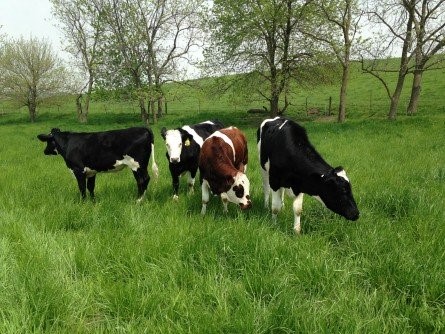Livestock grazing may be integrated into organic crop systems
Integrated organic crop and livestock production systems can conform to food safety standards.
December 19, 2019

Experiments involving the integration of cattle into crop rotations in organic food production showed that such systems performed well at keeping pathogens out of meat, according to a recently published study.
In an announcement describing the results, Iowa State University said the study involved three experimental organic farming systems on which crops were rotated with cattle. Researchers found no traces of common strains of Escherichia coli or salmonella on the meat produced in the experiments, and pathogens detected in feed, fecal and hide samples remained below thresholds commonly detected in conventional production systems.
Kathleen Delate, a professor of horticulture and agronomy at Iowa State and one of the authors of the study, said the results show promise for the potential of farmers to integrate animal and crop production.
Experiments have shown that such arrangements can help farmers realize a number of benefits, including better soil health, but Delate said no previous studies of such systems in the Midwest focused on food safety.
“Our feeling is that this kind of integration could be a practice more and more farmers could adopt for a variety of reasons,” Delate said. “Farmers are interested and are looking to universities and researchers for advice on how to get it done.”
The study, published in the journal Renewable Agriculture & Food Systems, included findings from three experimental farms in Iowa, Minnesota and Pennsylvania. A small number of cattle grazed on small grain (wheat and rye) pastures on the farms, and then corn and soybeans were planted on the same acres the following year before the land was returned to grazing pasture, the announcement said. This differs from common agricultural practices in which animal and crop production are kept separate.
The research team monitored the integrated systems for a range of results, including whether such an arrangement could pose food safety risks via cross-contamination. They found that adhering to standard food safety practices produced meat and grain that, compared to conventional farming practices, was as safe as or safer for consumption, Iowa State said.
None of the meat samples tested positive for E. coli O157:H7 or for salmonella. Testing of cattle hide, feed and fecal samples returned some positive results for pathogens, but those results were in line with studies from conventional operations, the researchers said.
“The integrated crop/livestock system in this study demonstrated a high probability of meeting food safety goals for limiting E. coli O157:H7 and Salmonella spp. contamination in the forage, feed, feces, hide and meat of grass-based organic cattle,” the study concluded.
Delate said the study also found evidence that integrated management yields benefits for soil health, but she said those results will likely appear in a separate publication.
Angela Shaw, an associate professor of food science and human nutrition at Iowa State, also contributed to the study, as did Robert Turnbull, an Iowa State program coordinator in horticulture, and Joshua Nazareth, a former Iowa state student.
You May Also Like



